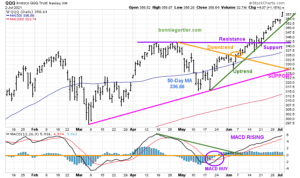Weakening Momentum Patterns Long Term Should Not Be Ignored This Time
After four straight months of gains in 2019, the bears took control in May, which generated high levels of pessimism. However, May’s decline seems like an afterthought, as the possibility of lower interest rates ignited the Nasdaq Composite, the Dow Industrials and the S&P 500 to new all-time highs in July. Support levels and price trends on the major averages remain intact. Market breadth (the NYSE Advance-Decline Line) made a new all-time high confirming the new highs in the major averages which would normally imply that the final high most likely has yet to be seen. High Yield Bond Mutual Funds and High Yield ETFs (HYG) are strong, trading at or near their highs. However, I believe now is not the time to load up on U.S equities and its more important to pay attention to how your portfolio is moving so you are prepared if the market were to decline sharply suddenly.
Trouble ahead?
On the negative side, the short and intermediate term technical picture is overbought, no longer oversold after the gains made in 2019. The upcoming months may be somewhat challenging for the rally to continue as historically many big declines have occurred during July through October. The tape action is not all favorable. Key indices such as the Dow Transportation Average (IYT), the Russell 2000 Index (IWM), and the S&P MidCap 400 (MDY) Index are well below their all-time highs. The Financials sector is also not confirming the major averages highs, with the Regional Bank (KRE) and Finance (XLF) ETF not making a new high. Long term momentum patterns are showing weakening momentum.
Where do we go from here?

Figure: INVESCO (QQQ) (Nasdaq 100 Index) Monthly Price (Top) and 12-26-9 MACD (Bottom)
The top part chart shows the weekly Invesco QQQ Trust (QQQ), (***See below for top holdings) an exchange-traded fund based on the Nasdaq 100 Index, and its 50-month moving average. A moving average is commonly used to define the present trend.
Technology has been one of the strongest sectors of the stock market throughout the bull market. The QQQ has been in a long term up-trend since March of 2009. The QQQ is trading at 192.33 at the time of this writing making a new all-time intraday high. The QQQ is well above its rising 50-month Moving Average (blue line) which continues to act as support and presently is 142.24. Only in August 2015 (green circle), did the QQQ become close to falling below its 50-month Moving Average. A powerful rally followed before a peak was made on 10/18 at 187.53 (red circle) then falling -23.5% to a low of 143.50 on 12/24/18. In July 2019 the QQQ made a new all-time high. A likely area of support, if there would be a sudden sharp decline in the QQQ is 142.24, the 50-month moving average (blue line). The next support area would be at 120.00, the long-term uptrend line (in orange).
The bottom half of the chart is MACD (12, 26, 9 ), a technical indicator that measures momentum. MACD rose to an overbought condition in late 2018, generating a sell turning down after making a higher high confirming the QQQ price high. Many times, the first sell is premature after a strong rally, and declines that follow soon thereafter are short and another advance occurs. This is indeed what happened. Now, MACD has a more dangerous looking pattern. A turndown in MACD would complete a negative divergence and there is also a good chance the uptrend (orange line) could be broken at the same time. Therefore, when MACD gives its next sell, this is the one you want to make sure that you follow. Without the strength of Technology stocks supporting the market, when the long-term trend does turn down, it’s likely the stock market will struggle, volatility would rise sharply, and risk would increase.
*** The Invesco QQQ Trust QQQ is one of the most traded ETFs in the world and includes 104 of the largest domestic and international nonfinancial companies listed on the Nasdaq. As of 7/8/19, the top holdings are Microsoft Corp (MSFT) 11.26%, Amazon Inc. (AMZN) 10.32%, Apple (AAPL) 9.88%, Facebook, Inc. Class A (FB) 5.10%, and Alphabet Inc. Class C (GOOG) 4.20%, totaling 40.76%. (Source: //www.etf.com/qqq).
Figure: SPDR SPY (S&P 500 Index) Monthly Price (Top) and 12-26-9 MACD (Bottom)

The chart above is the monthly (long-term) price of the SPDR S&P 500 (SPY) and its 50-month moving average. The top portion of the chart shows the long-term trend of the S&P 500 (SPY) in an uptrend since 2009 (black line), including the decline in 2018 (green circle). The SPY also stayed above its 50-month moving average which acted as support and then reversed sharply higher making a new all-time high in July 2019.
Unlike the QQQ, the 50-month moving average is below the long-term uptrend line. If a decline were to begin, a likely area of support would be at 243.63, its 50-month moving average, although the uptrend would remain intact. Any close below 231.00 on the SPY would be negative and potentially could signal the end to the bull market.
The bottom half of the chart is MACD, a momentum indicator. MACD broke its uptrend from 2009 (black line) but confirmed the September high last year made in the S&P 500 (SPY). MACD remains below the uptrend, (unlike the MACD pattern of the QQQ), and is giving a warning of weakening momentum (similar to the QQQ) implying a more serious decline may begin. Caution is warranted.
***The SPDR S&P 500 (SPY) is made up of 506 stocks of the largest companies in the U.S. As of 7/9/19, the top 5 holdings in the S&P 500 were Microsoft Corporation (MSFT) 4.23 %, Apple Inc. (AAPL) 3.52%, Amazon (AMZN) 3.25%, Facebook Inc. Class A (FB) 1.89%, and Berkshire Hathaway Inc. Class B (BRK/B) 1.68%, totaling 14.57%. The top 5 sectors are: Technology 25.73%, Financials 16.78%, Healthcare 14.05%, Consumer Cyclicals 13.28%, and Industrials 10.34%, totaling 79.68%. (Source: //www.etf.com/SPY.)
Summing Up:
The long-term major price trend remains up for as long as the QQQ remains above 120.00, and the SPY remains above 231.00. Both made new intraday highs on 7/10/19. For now, the bulls remain in control. However, there are clear signs of weakening momentum. The stock market will not ring a bell when the final top is made. Now that new highs have been achieved, the question is how sustainable the rally is. There are many other averages that are well below their new highs, not confirming the major averages July new all-time highs. It’s not the time to forget about your portfolio. What will stall the advance and be the catalyst to cause a potential trend change going forward remains unknown. It could be disappointments in the upcoming earnings season, an unexpected outcome in the U.S. and China trade deal, or a slowdown of economic growth that could trigger a market decline. Therefore, make sure you review your investment portfolio and have an exit plan in place that suits your risk if a sharp decline were to begin. If you need assistance, remember we are here for you.
Drop me a line! I’d love to hear from you. Please call me at 516-829-6444 or email at bgortler@signalert.com to share your thoughts or ask me any questions you might have.
Sign up for a FREE 3 issue trial of
SYSTEMS AND FORECASTS Click here
******Article published in Systems and Forecasts by Bonnie Gortler July 10, 2019
Disclaimer: Although the information is made with a sincere effort for accuracy, it is not guaranteed that the information provided is a statement of fact. Nor can we guarantee the results of following any of the recommendations made herein. Readers are encouraged to meet with their own advisors to consider the suitability of investments for their own particular situations and for determination of their own risk levels. Past performance does not guarantee any future results.

If you like this article you will love my
Free EBook Grow Your Wealth and Well-Being Ebook













